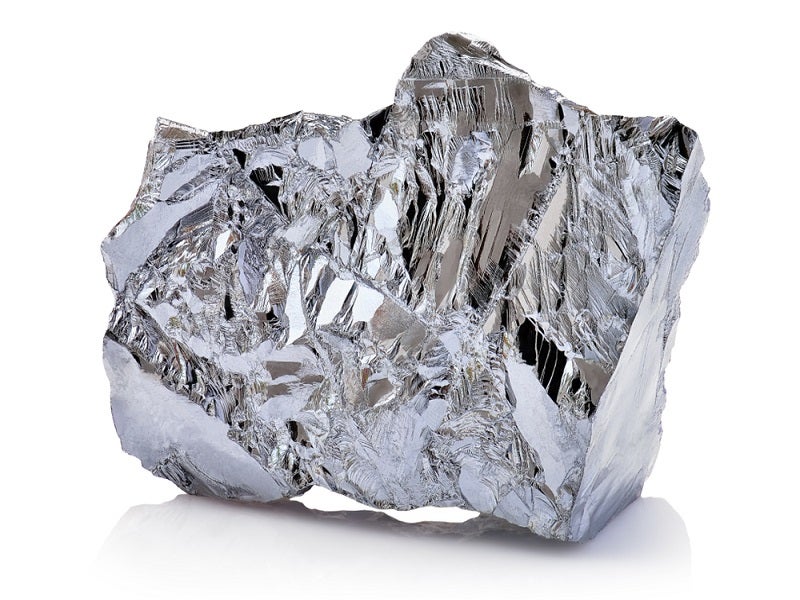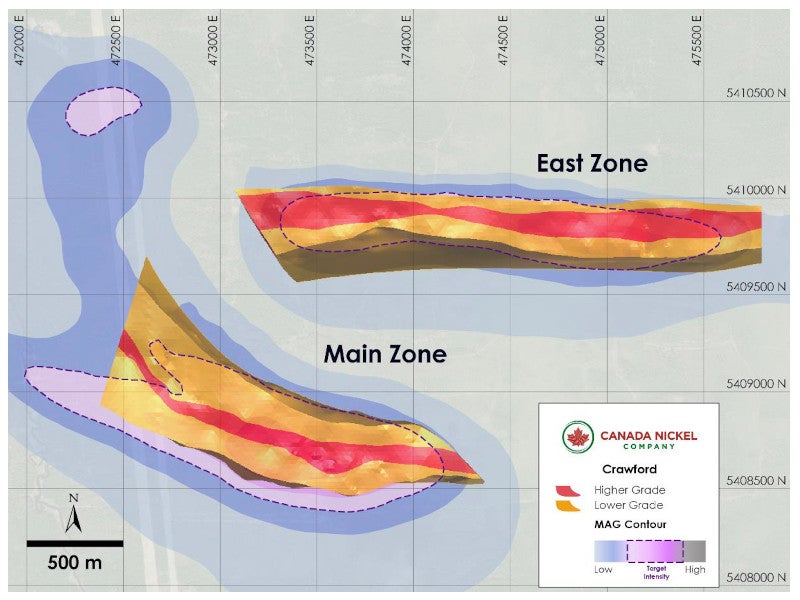The Crawford nickel sulphide project in Ontario, Canada, is being developed by Canada Nickel Company (CNC), an exploration company focused on nickel.
Crawford is expected to be among the top five largest nickel sulphide operations in the world supplying nickel to manufacturers of stainless steel and electric vehicle batteries.
CNC acquired the project from mineral exploration company Noble Mineral Exploration in November 2019.
A memorandum of understanding (MoU) was signed by CNC with Mattagami First Nation and Matachewan First Nation in 2020 regarding the exploration and development activities at the project.
The feasibility study (FS) for the project is currently ongoing and is expected to be completed by the end of 2022. The estimated mine life of the project is 25 years.
Location and geology of the Crawford project
The Crawford nickel sulphide project is located 42km north of Timmins in the Timmins-Cochrane Mining Camp of northeastern Ontario. It lies in the western part of the mineral-rich Abitibi Greenstone Belt, which runs along the Ontario-Quebec provincial boundary and is the world’s largest and best-preserved greenstone belt.
The Crawford project is primarily composed of two deposits, namely the main zone (MZ) and the east zone (EZ).
The underlying rocks at the project site are part of the Deloro Assemblage, which hosts the Crawford Ultramafic Complex (CUC). The assemblage primarily consists of mafic to felsic calc-alkaline volcanic rocks with local tholeiitic mafic volcanic units and an iron formation cap made of chert-magnetite and containing low levels of iron.
Mineralisation of the Canada-based nickel-sulphide project
The nickel sulphide mineralisation at the Crawford project is characterised as a komatiite-hosted Ni-Cu-Co-(PGE) deposit, which is similar to the Dumont nickel deposit in Quebec, Canada.
Nickel mineralisation in the main zone is a mixture of pentlandite, heazlewoodite and awaruite, which combine to form the high-grade core. Heazlewoodite and awaruite, with minor levels of pentlandite, are the predominant nickel minerals in the low-grade domains.
Most of the nickel mineralisation in the east zone is made up of heazlewoodite, with smaller amounts of awaruite.
Reserves of the Crawford project
The overall measured and indicated resources of the project are 1,425.1 million tonnes (Mt) grading 0.24% nickel, while the inferred resources are estimated to be 670.1Mt grading 0.23% nickel, as of July 2022.
The project is also estimated to contain measured and indicated resources of 1.06 million ounces (Moz) of palladium and platinum, 8.5Mt of chromium, 183,000t of cobalt, and 93.9Mt of iron.
Mining at Crawford nickel-sulphide project
The Crawford mine plan design includes the mining of 2,794Mt of ore over its mine life, including two years of pre-stripping prior to the commissioning of the process plant.
The Crawford mine plan comprises three separate open pits, including the main zone (MZ), east zone-west (EZ-W), and east zone-east (EZ-E).
The MZ is the largest and will be the first to be mined. Mining at EZ-W will start during the final year of MZ operation, while that at EZ-E will begin two years after commencing mining at EZ-W.
The mining activities will not require any overburden drilling or blasting as 85% of the rock is homogenous, which allows bulk blasting on 15m benches with 311mm holes. The remaining 15% of the rock will be removed using 229mm holes and 7.5m flitches.
Crawford will employ autonomous drill systems (ADS), enabling the use of blow hole drills without onboard operators.
The mining fleet will comprise small backhoe excavators, 40t articulated trucks, medium-sized face shovel excavators, 90t haul trucks, 290t haul trucks, and electrically driven face shovel excavators.
The 290t haul trucks will use autonomous haulage systems (AHS) that do not require onboard operators. Trolley-assisted truck hauling will increase the speed of operation and reduce the energy consumption of the 290t haul trucks on uphill load hauls.
Processing details
The processing facility will use a conventional milling process that includes crushing, grinding, desliming and flotation in line with standard ultramafic nickel operations.
The run of mine (ROM) ore will undergo primary and secondary crushing in a semi-autogenous grinding (SAG) mill and a ball mill grinding circuit, followed by desliming through hydrocycloning.
The concentrate from the desliming circuit will undergo flotation and magnetic separation to recover nickel sulphide and magnetite concentrate. The concentrate will be thickened, filtered, and stockpiled on-site before being loaded onto railcars or trucks for delivery to offsite smelters.
The process plant for the project will be developed in three phases. Phase one development will include a processing capacity of 42,500 tonnes per day (tpd), which will be increased to 85,000tpd in phase two. Phase three will add secondary crushing, a third ball mill, and more downstream capacity to increase the processing capacity to 120,000tpd.
A non-binding MoU was signed between CNC and Glencore in January 2021 for the potential usage and/or modification of the latter’s Kidd concentrator and metallurgical plant for the small-scale start-up of the project. The concentrator is located about 40km south of the Crawford property.
Infrastructure of the Crawford project
The Crawford project is accessible from Provincial Highway 655. A 13.2km section of the highway will need to be realigned as it passes across the pit envelope.
A 20km rail spur that services the processing plant is planned to be developed for the project. The rail spur will connect to Glencore’ Kidd Operations rail line.
Power for phases one and two of the project will be sourced through a 2.5km overhead powerline connected to the existing H6T and H7T transmission lines of the provincial utility Hydro One.
A new 38km-long, 230kV overhead powerline that will connect to an existing transmission line in Timmins will be built in phase three. The line will connect to a new 120kV substation and six main transformers installed near the processing plant.
Surface water storage at the sedimentation pond and groundwater wells will provide freshwater and make-up water. Water recycled from the tailings storage facility will be used to meet a considerable portion of the water requirement for the mine’s operations.
Financing
CNC signed an MoU with the Taykwa Tagamou Nation in December 2020 to establish a long-term, mutually advantageous economic relationship.
A second MoU was signed in April 2021 to finance the mine fleet for the project.
Contractors involved in the Crawford project
The technical report and preliminary economic assessment for the project were prepared by Ausenco Engineering Canada, an engineering company; Caracle Creek, a mineral exploration consulting company; and Wood Canada, a consulting and engineering company.
Independent mining consultant David Penswick was hired to develop an open-pit mine design, mine production schedule, and financial model of the project.
Engineering and consulting firm Golder and Wood Canada were appointed to collect the environmental data needed for the environmental social impact assessment (ESIA).
Transfer Environment and Society (TES), a consulting firm specialising in community engagement, was contracted to design and implement the community consultation approach.






